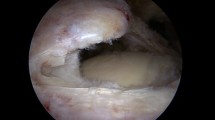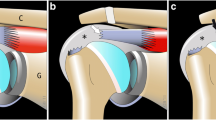Abstract
Purpose
To investigate the change in tendon length with increasing size of rotator cuff tears in patients receiving arthroscopic rotator cuff repair.
Methods
This is a prospective evaluation of 100 consecutive patients who met the inclusion criterion of a U-shaped or crescent-shaped full-thickness tear and who were treated by arthroscopic rotator cuff (supraspinatus and/or infraspinatus) repair from 2009 to 2010. The anterior-to-posterior dimension of the cuff tear was estimated under arthroscopic guidance, and the medial-to-lateral dimension was estimated on pre-operative MRI. The tendon length, from its distal end to the musculotendinous junction, was estimated under arthroscopic observation after arthroscopic rotator cuff repair. The relationships between tendon length and the anterior-to-posterior and medial-to-lateral dimensions of the cuff tear were analyzed.
Results
The average tendon length in patients with full-thickness tears was 17.0 mm. The tendon length decreased significantly with an increase in cuff tear size, for both the anterior-to-posterior (r = −0.328, P = 0.001) and medial-to-lateral dimensions (r = −0.681, P < 0.001). When the full-thickness tears were grouped according to the lengths of the anterior-to-posterior and medial-to-lateral dimensions, tendon length differed significantly among the groups (P = 0.008 and P < 0.001, respectively).
Conclusions
In full-thickness tears, the rotator cuff tendon length decreased with increases in the anterior-to-posterior and medial-to-lateral dimensions of the tear size, with a higher correlation between tendon length and the medial-to-lateral dimension. During arthroscopic rotator cuff repair, passing a suture too medially for complete footprint coverage using a strong fixation technique can lead to excess tension and medial cuff tears.
Level of evidence
II.



Similar content being viewed by others
References
Barber FA, Coons DA, Ruiz-Suarez M (2007) Cyclic load testing of biodegradable suture anchors containing 2 high-strength sutures. Arthroscopy 23:355–360
Bardana DD, Burks RT, West JR, Greis PE (2003) The effect of suture anchor design and orientation on suture abrasion: an in vitro study. Arthroscopy 19:274–281
Bishop J, Klepps S, Lo IK, Bird J, Gladstone JN, Flatow EL (2006) Cuff integrity after arthroscopic versus open rotator cuff repair: a prospective study. J Should Elb Surg 15:290–299
Bynum CK, Lee S, Mahar A, Tasto J, Pedowitz R (2005) Failure mode of suture anchors as a function of insertion depth. Am J Sports Med 33:1030–1034
Cho NS, Yi JW, Lee BG, Rhee YG (2010) Retear patterns after arthroscopic rotator cuff repair: single-row versus suture bridge technique. Am J Sports Med 38:664–671
Cummins CA, Murrell GA (2003) Mode of failure for rotator cuff repair with suture anchors identified at revision surgery. J Should Elb Surg 12:128–133
Fallon J, Blevins FT, Vogel K, Trotter J (2002) Functional morphology of the supraspinatus tendon. J Orthop Res 20:920–926
Franceschi F, Ruzzini L, Longo UG, Martina FM, Zobel BB, Maffulli N, Denaro V (2007) Equivalent clinical results of arthroscopic single-row and double-row suture anchor repair for rotator cuff tears: a randomized controlled trial. Am J Sports Med 35(8):1254–1260
Gerber C, Meyer DC, Frey E et al (2009) Neer Award 2007: reversion of structural muscle changes caused by chronic rotator cuff tears using continuous musculotendinous traction. An experimental study in sheep. J Should Elb Surg 18:163–171
Goutailler D, Postel JM, Gleyze P, Leguilloux P, Van Driessche S (2003) Influence of cuff muscle fatty degeneration on anatomic and functional outcomes after simple suture full-thickness tears. J Should Elb Surg 12:550–554
Itoi E, Hsu HC, Carmichael SW, Morrey BF, An KN (1995) Morphology of the torn rotator cuff. J Anat 186(Pt 2):429–434
Jost B, Pfirrmann CW, Gerber C (2000) Clinical outcome after structural failure of rotator cuff repairs. J Bone Jt Surg Am 82:304–314
Kim DH, Elattrache NS, Tibone JE et al (2006) Biomechanical comparison of a single-row versus double-row suture anchor technique for rotator cuff repair. Am J Sports Med 34:407–414
Lambert A, Loffroy R, Guiu B et al (2009) Rotator cuff tears: value of 3.0T MRI. J Radiol 90:583–588
Liu SH, Baker CL (1994) Arthroscopically assisted rotator cuff repair: correlation of functional results with integrity of the cuff. Arthroscopy 10:54–60
Mahar A, Allred DW, Wedemeyer M, Abbi G, Pedowitz R (2006) A biomechanical and radiographic analysis of standard and intracortical suture anchors for arthroscopic rotator cuff repair. Arthroscopy 22:130–135
Meier SW, Meier JD (2006) The effect of double-row fixation on initial repair strength in rotator cuff repair: a biomechanical study. Arthroscopy 22:1168–1173
Pennington WT, Gibbons DJ, Bartz BA, Dodd M, Daun J, Klinger J, Popovich M, Butler B (2010) Comparative analysis of single-row versus double-row repair of rotator cuff tears. Arthroscopy 26(11):1419–1426
Su WR, Budoff JE, Luo ZP (2009) The effect of anterosuperior rotator cuff tears on glenohumeral translation. Arthroscopy 25:282–289
Trantalis JN, Boorman RS, Pletsch K, Lo IK (2008) Medial rotator cuff failure after arthroscopic double-row rotator cuff repair. Arthroscopy 24:727–731
Author information
Authors and Affiliations
Corresponding author
Additional information
This study was financially supported by a research fund from Chungnam National University Hospital in 2009.
Rights and permissions
About this article
Cite this article
Kim, K.C., Shin, H.D., Kim, B.K. et al. Changes in tendon length with increasing rotator cuff tear size. Knee Surg Sports Traumatol Arthrosc 20, 1022–1026 (2012). https://doi.org/10.1007/s00167-011-1664-0
Received:
Accepted:
Published:
Issue Date:
DOI: https://doi.org/10.1007/s00167-011-1664-0




